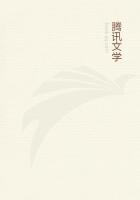Because of the moisture and heat of his body he may produce many [for semen is naturally fluid and hot], but because of his size he produces few or one.On account of this it results that in man alone among animals the period of gestation is irregular; whereas the period is fixed in the rest, there are several periods in man, for children are born at seven months and at ten months and at the times between, for even those of eight months do live though less often than the rest.The reason may be gathered from what has just been said, and the question has been discussed in the Problems.Let this explanation suffice for these points.
The cause why the parts may be multiplied contrary to Nature is the same as the cause of the birth of twins.For the reason exists already in the embryo, whenever it aggregates more material at any point of itself than is required by the nature of the part.The result is then that either one of its parts is larger than the others, as a finger or hand or foot or any of the other extremities or limbs; or again if the embryo is cleft there may come into being more than one such part, as eddies do in rivers; as the water in these is carried along with a certain motion, if it dash against anything two systems or eddies come into being out of one, each retaining the same motion; the same thing happens also with the embryos.The abnormal parts generally are attached near those they resemble, but sometimes at a distance because of the movement- taking place in the embryo, and especially because of the excess of material returning to that place whence it was taken away while retaining the form of that part whence it arose as a superfluity.
In certain cases we find a double set of generative organs [one male and the other female].When such duplication occurs the one is always functional but not the other, because it is always insufficiently supplied with nourishment as being contrary to Nature; it is attached like a growth (for such growths also receive nourishment though they are a later development than the body proper and contrary to Nature.) If the formative power prevails, both are similar; if it is altogether vanquished, both are similar; but if it prevail here and be vanquished there, then the one is female and the other male.(For whether we consider the reason why the whole animal is male or female, or why the parts are so, makes no difference.)When we meet with deficiency in such parts, e.g.an extremity or one of the other members, we must assume the same cause as when the embryo is altogether aborted (abortion of embryos happens frequently).
Outgrowths differ from the production of many young in the manner stated before; monsters differ from these in that most of them are due to embryos growing together.Some however are also of the following kind, when the monstrosity affects greater and more sovereign parts, as for instance some monsters have two spleens or more than two kidneys.Further, the parts may migrate, the movements which form the embryo being diverted and the material changing its place.We must decide whether the monstrous animal is one or is composed of several grown together by considering the vital principle; thus, if the heart is a part of such a kind then that which has one heart will be one animal, the multiplied parts being mere outgrowths, but those which have more than one heart will be two animals grown together through their embryos having been confused.
It also often happens even in many animals that do not seem to be defective and whose growth is now complete, that some of their passages may have grown together or others may have been diverted from the normal course.Thus in some women before now the os uteri has remained closed, so that when the time for the catamenia has arrived pain has attacked them, till either the passage has burst open of its own accord or the physicians have removed the impediment; some such cases have ended in death if the rupture has been made too violently or if it has been impossible to make it at all.In some boys on the other hand the end of the penis has not coincided with the end of the passage where the urine is voided, but the passage has ended below, so that they crouch sitting to void it, and if the testes are drawn up they appear from a distance to have both male and female generative organs.The passage of the solid food also has been closed before now in sheep and some other animals; there was a cow in Perinthus which passed fine matter, as if it were sifted, through the bladder, and when the anus was cut open it quickly closed up again nor could they succeed in keeping it open.
We have now spoken of the production of few and many young, and of the outgrowth of superfluous parts or of their deficiency, and also of monstrosities.














